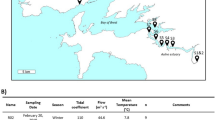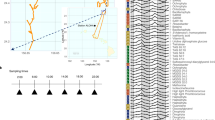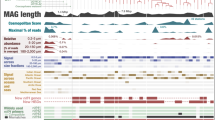Abstract
Depending on their relationship with the pelagic particulate matter, planktonic prokaryotes have traditionally been classified into two types of communities: free-living (FL) or attached (ATT) to particles, and are generally separated using only one pore-size filter in a differential filtration. Nonetheless, particulate matter in the oceans appears in a continuum of sizes. Here we separated this continuum into six discrete size-fractions, from 0.2 to 200 μm, and described the prokaryotes associated to each of them. Each size-fraction presented different bacterial communities, with a range of 23–42% of unique (OTUs) in each size-fraction, supporting the idea that they contained distinct types of particles. An increase in richness was observed from the smallest to the largest size-fractions, suggesting that increasingly larger particles contributed new niches. Our results show that a multiple size-fractionation provides a more exhaustive description of the bacterial diversity and community structure than the use of only one filter. In addition, and based on our results, we propose an alternative to the dichotomy of FL or ATT lifestyles, in which we differentiate the taxonomic groups with preference for the smaller fractions, those that do not show preferences for small or large fractions, and those that preferentially appear in larger fractions.
Similar content being viewed by others
Log in or create a free account to read this content
Gain free access to this article, as well as selected content from this journal and more on nature.com
or
References
Acinas SG, Antón J, Rodríguez-Valera F . (1999). Diversity of free-living and attached bacteria in offshore western Mediterranean waters as depicted by analysis of genes encoding 16S rRNA. Appl Environ Microb 65: 514–522.
Alldredge AL, Cole JJ, Caron DA . (1986). Production of heterotrophic bacteria inhabiting macroscopic surface organic aggregates (marine snow) from surface waters. Limnol Oceanogr 31: 68–78.
Alldredge AL, Cohen Y . (1987). Can microscale chemical patches persist in the sea? Microelectrode study of marine snow, fecal pellets. Science 235: 689–691.
Allen ZL, Allen EE, Badger JH, McCrow JP, Paulsen IT, Elbourne LDH et al. (2012). Influence of nutrients and currents on the genomic composition of microbes across an upwelling mosaic. ISME J 6: 1403–1414.
Almeda R, Calbet A, Alcaraz M, Saiz E, Trepat I, Arin L et al. (2011). Trophic role and carbon budget of metazoan microplankton in northwest Mediterranean coastal waters. Limnol Oceanogr 56: 415–430.
Azam F, Smith DC, Steward GF, Hagström A . (1993). Bacteria-organic matter coupling and its significance for oceanic carbon cycling. Microb Ecol 28: 167–179.
Azam F . (1998). Microbial control of oceanic carbon flux: the plot thickens. Science 280: 694–696.
Azam F, Malfatti F . (2007). Microbial structuring of marine ecosystems. Nat Rev Microbiol 5: 782–791.
Bauld J, Staley JT . (1976). Planctomyces maris sp. nov.: a marine isolate of the Planctomyces-Blastocaulis group of budding bacteria. J Gen Microbiol 97: 45–55.
Baumann P, Baumann L, Bang S, Woolkalis MJ . (1980). Reevaluation of the taxonomy of Vibrio Beneckea, and Photobacterium: abolition of the genus. Beneckea. Current Microbiol 4: 127–132.
Bengtsson MM, Øvreås L . (2010). Planctomycetes dominate biofilms on surfaces of the kelp Laminaria hyperborea. BMC Microbiol 10: 261.
Bickel SL, Tang KW, Grossart HP . (2014). Structure and function of zooplankton-associated bacterial communities in a temperate estuary change more with time than with zooplankton species. Aquat Microb Ecol 72: 1–15.
Bižic-Ionescu M, Zeder M, Ionescu D, Orlic S, Fuchs BM, Grossart HP et al. (2015). Comparison of bacterial communities on limnic versus coastal marine particles reveals profound differences in colonization. Environ Microbiol 17: 3500–3514.
Brown MV, Fuhrman JA . (2005). Marine bacterial microdiversity as revealed by internal transcribed spacer analysis. Aquat Microb Ecol 41: 15–23.
Buchan A, LeCleir GR, Gulvik CA, González JM . (2014). Master recyclers: features and functions of bacteria associated with phytoplankton blooms. Nat Rev Microbiol 12: 686–698.
Calbet A, Garrido S, Saiz E, Alcaraz M . (2001). Annual zooplankton succession in coastal NW Mediterranean waters: the importance of the smaller size fractions. J Plankton Res 23: 319–331.
Caporaso JG, Kuczynski J, Stombaugh J, Bittinger K, Bushman FD, Costello EK et al. (2010). QIIME allows analysis of high-throughput community sequencing data. Nat Methods 7: 335–336.
Crespo BG, Pommier T, Fernández-Gómez B, Pedrós-Alió C . (2013). Taxonomic composition of the particle-attached and free-living bacterial assemblages in the Northwest Mediterranean Sea analyzed by pyrosequencing of the 16S rRNA. MicrobiologyOpen 2: 541–552.
Crump BC, Armbrust EV, Baross JA . (1999). Phylogenetic analysis of particle-attached and free-living bacterial communities in the Columbia River, its estuary, and the adjacent coastal ocean. Appl Environ Microb 65: 3192–3204.
Dang H, Lovell CR . (2002). Seasonal dynamics of particle-associated and free-living marine Proteobacteria in a salt marsh tidal creek as determined using fluorescence in situ hybridization. Environ Microb 4: 287–295.
Delong EF, Franks DG, Alldredge AL . (1993). Phylogenetic diversity of aggregate-attached vs free-living marine bacterial assemblages. Limnol Oceanogr 38: 924–934.
Dufrene M, Legendre P . (1997). Species assamblages and indicator species: the need for a flexible asymetrical approach. Ecol Monograph 67: 345–366.
Eloe EA, Shulse CN, Fadrosh DW, Williamson SJ, Allen EE, Bartlett DH . (2011). Compositional differences in particle-associated and free-living microbial assemblages from an extreme deep-ocean environment. Environ Microbiol Rep 3: 449–458.
Fenchel T . (2001). Eppur si muove: many water column bacteria are motile. Aquat Microb Ecol 24: 197–201.
Fuchsman CA, Kirkpatrick JB, Brazelton WJ, Murray JW, Staley JT . (2011). Metabolic strategies of free-living and aggregate-associated bacterial communities inferred from biologic and chemical profiles in the Black Sea suboxic zone. FEMS Microbiol Ecol 78: 586–603.
Fuerst J, Gwilliam HG, Lindsay M, Lichanska A, Belcher C, Vickers JE et al. (1997). Isolation and molecular identification of planctomycete bacteria from postlarvae of the giant tiger prawn, Penaeus monodon. Appl Environ Microb 63: 254–262.
Ganesh S, Parris DJ, DeLong EF, Stewart FJ . (2014). Metagenomic analysis of size-fractionated picoplankton in a marine oxygen minimum zone. ISME J 8: 187–211.
García-Martínez J, Rodríguez-Valera F . (2000). Microdiversity of uncultured marine prokaryotes: The SAR11 cluster and the marine Archaea of Group I. Molecular Ecol 9: 935–948.
Gasol JM, Massana R, Simó R, Marrasé C, Acinas SG, Pedrós-Alió C et al. (2012). Blanes Bay. In: O'Brien TD, Li WK, Morán XAG (eds), ICES Phytoplankton and Microbial Plankton Status Report 2009/2010. ICES Cooperative Research Report no. 313. ICES: Copenhagen, Denmark. Available at: http://www.st.nmfs.noaa.gov/copepod/status-reports/crr313-wgpme_large.pdf.
Ghai R, Mizuno CM, Picazo A, Camacho A, Rodriguez-Valera F . (2013). Metagenomics uncovers a new group of low GC and ultra-small marine Actinobacteria. Sci Rep 3: 1–8.
Ghiglione J, Mevel G, Pujo-Pay M, Mousseau L, Lebaron P, Goutx M . (2007). Diel and seasonal variations in abundance, activity, and community structure of particle-attached and free-living bacteria in NW Mediterranean Sea. Microb Ecol 54: 217–231.
Giovannoni SJ, Tripp HJ, Givan S, Podar M, Vergin KL, Baptista D et al. (2005). Genome streamlining in a cosmopolitan oceanic bacterium. Science 309: 1214.
González JM, Fernández-Gómez B, Fernàndez-Guerra A, Gómez-Consarnau L, Sánchez O, Coll-Lladó M et al. (2008). Genome analysis of the proteorhodopsin-containing marine bacterium Polaribacter sp. MED152 (Flavobacteria). Proc Natl Acad Sci USA 105: 8724–8729.
Grossart HP, Riemann L, Azam F . (2001). Bacterial motility in the sea and its ecological implications. Aquat Microb Ecol 25: 247–258.
Grossart HP, Tang KW, Kiørboe T, Ploug H . (2007). Comparison of cell-specific activity between free-living and attached bacteria using isolates and natural assemblages. FEMS Microbiol Ecol 266: 194–200.
Grossart HP . (2010a). Ecological consequences of bacterioplankton lifestyles: changes in concepts are needed. Environ Microbiol Rep 2: 706–714.
Grossart HP, Dziallas C, Leunerta F, Tang KW . (2010b). Bacteria dispersal by hitchhiking on zooplankton. Proc Natl Acad Sci USA 107: 11959–11964.
Gutiérrez-Rodríguez A, Latasa M, Scharek R, Massana R, Vila G, Gasol JM . (2011). Growth and grazing rate dynamics of major phytoplankton groups in an oligotrophic coastal site. Estuar Coast Shelf Sci 95: 77–87.
Haas BJ, Gevers D, Earl AM, Feldgarden M, Ward DV, Giannoukos G et al. (2011). Chimeric 16S rRNA sequence formation and detection in Sanger and 454-pyrosequenced PCR amplicons. Genome Res 21: 494–504.
Hollibaugh JT, Wong PS, Murrell MC . (2000). Similarity of particle-associated and free-living bacterial communities in northern San Francisco Bay, California. Aquat Microb Ecol 21: 103–104.
Karl DM, Knauer GA, Martin JH, Ward BB . (1984). Bacterial chemolithotrophy in the ocean is associated with sinking particles. Nature 309: 54–56.
Karner M, Herndl GJ . (1992). Extracellular enzymatic activity and secondary production in free-living and marine-snow-associated bacteria. Mar Biol 113: 341–347.
Kellogg C, Deming J . (2009). Comparison of free-living, suspended particle, and aggregate-associated bacterial and archaeal communities in the Laptev Sea. Aquat Microb Ecol 57: 1–18.
Kirchman D . (2002). The ecology of Cytophaga-Flavobacteria in aquatic environments. FEMS Microbiol Ecol 39: 91–100.
Kirchman D, Mitchell R . (1982). Contribution of particle-bound bacteria to total microheterotrophic activity in five ponds and two marshes. Appl Environ Microbiol 43: 200–209.
Lage OM, Bondoso J . (2011). Planctomycetes diversity associated with macroalgae. FEMS Microbiol Ecol 78: 366–375.
Lapoussière A, Michel C, Starr M, Gosselin M, Poulin M . (2011). Role of free-living and particle-attached bacteria in the recycling and export of organic material in the Hudson Bay System. J Mar Syst 88: 434–445.
Levins R . (1968) Evolution in Changing Environments. Princeton University Press: Princeton, NJ, USA.
Li JY, Wu CF . (2005). New symbiotic hypothesis on the origin of eukaryotic flagella. Naturwissenschaften 92: 305–309.
Long RA, Azam F . (2001). Microscale patchiness of bacterioplankton assemblage richness in seawater. Aquat Microb Ecol 26: 103–113.
Malfatti F, Azam F . (2009). Atomic force microscopy reveals microscale networks and possible symbioses among pelagic marine bacteria. Aquat Microb Ecol 58: 1–14.
Martinez-Garcia M, Brazel DM, Swan BK, Arnosti C, Chain PSG, Reitenga KG et al. (2012). Capturing single cell genomes of active polysaccharide degraders: an unexpected contribution of Verrucomicrobia. PLoS One 7: e35314.
Massana R, Murray AE, Preston CM, DeLong E . (1997). Vertical distribution and phylogenetic characterization of marine planktonic archaea in the Santa Barbara Channel. Appl Environ Microbiol 63: 50–56.
Milici M, Tomasch J, Wos-Oxley M, Wang H, Jáuregui R, Camanirha-Silva A et al. (2016). Low diversity of planktonic bacteria in the tropical ocean. Sci Rep 6: 19054.
Mitchell JG, Pearson L, Dillon S, Kantalis K . (1995). Natural assemblages of marine bacteria exhibiting high-speed motility and large accelerations. Appl Environ Microbiol 61: 4436–4440.
Moeseneder MM, Winter C, Herndl GJ . (2001). Horizontal and vertical complexity of attached and free-living bacteria of the eastern Mediterranean Sea, determined by 16 S rDNA and 16 S rRNA fingerprints. Limnol Oceanogr 46: 95–107.
Morel A, Ahn YH, Partensky F, Vaulot D, Claustre H . (1993). Prochlorococcus and Synechococcus: a comparative study of their optical properties in relation to their size and pigmentation. J Mar Res 51: 617–649.
Ortega-Retuerta E, Joux F, Jeffrey WH, Ghiglione JF . (2013). Spatial variability of particle-attached and free-living bacterial diversity in surface waters from the Mackenzie River to the Beaufort Sea (Canadian Arctic). Biogeosciences 10: 2747–2759.
Petroni G, Spring S, Schleifer KH, Verni F, Rosati G . (2000). Defensive extrusive ectosymbionts of Euplotidium (Ciliophora) that contain microtubule-like structures are bacteria related to Verrucomicrobia. Proc Natl Acad Sci USA 97: 1813–1817.
Pinel-Alloul B, Ghadouani A . (2007) Spatial heterogeneity of planktonic microorganisms in aquatic systems. In: Franklin R, Mills A (eds). The Spatial Distribution of Microbes in the Environment. Springer Press: Dordrecht, pp 210–310.
Pinhassi J, Sala MM, Havskum H, Peters F, Guadayol Ò, Malits A et al. (2004). Changes in bacterioplankton composition under different phytoplankton regimes. Appl Environ Microb 70: 6753–6766.
Rath J, Wu KY, Herndl GJ, DeLong EF . (1998). High phylogenetic diversity in a marine-snow-associated bacterial assemblage. Aquat Microb Ecol 14: 261–269.
Sala MM, Balagué V, Pedrós-Alió C, Massana R, Felipe J, Arin L et al. (2005). Phylogenetic and functional diversity of bacterioplankton during Alexandrium spp. blooms. FEMS Microbiol Ecol 54: 257–267.
Salazar G, Cornejo-Castillo FM, Borrull E, Díez C, Lara E, Vaqué D et al. (2015). Particle-association lifestyle is a phylogenetically conserved trait in bathypelagic prokaryotes. Mol Ecol 24: 5692–5706.
Satinsky BM, Crump BC, Smith CB, Sharma S, Zielinski BL, Doherty M et al. (2014). Microspatial gene expression patterns in the Amazon River Plume. Proc Natl Acad Sci USA 111: 11085–11090.
Schapira M, McQuaid CD, Froneman PW . (2012). Metabolism of free-living and particle-associated prokaryotes: Consequences for carbon flux around a Southern Ocean archipelago. J Marine Syst 90: 58–66.
Schink B, Pfennig N . (1982). Propionigenium modestum gen. nov. sp. nov. a new strictly anaerobic, nonsporing bacterium growing on succinate. Archiv Microbiol 133: 209–216.
Schlesner H, Rensmann C, Tindall BJ, Gade D, Rabus R et al. (2004). Taxonomic heterogeneity within the Planctomycetales as derived by DNA-DNA hybridization, description of Rhodopirellula baltica gen. nov., sp. nov., transfer of Perillula marina to the genus Blastopirellula gen. nov. as Blastopirellula marina comb. nov. and emended description of the genus Pirellula. Int J Syst Evol Microbiol 54: 1567–1580.
Schloss PD, Westcott SL, Ryabin T, Hall JR, Hartmann M, Hollister EB et al. (2009). Introducing mothur: open-source, platform-independent, community-supported software for describing and comparing microbial communities. Appl Environ Microbiol 75: 7537–7541.
Seymour JR, Mitchell JG, Seuront L . (2004). Microscale heterogeneity in the activity of coastal bacterioplankton communities. Aquat Microb Ecol 35: 1–16.
Sieburth JM, Smetacek V, Lenz J . (1978). Pelagic ecosystem structure: heterotrophic compartments of the plankton and their relationship to plankton size fractions. Limnol Oceanogr 23: 1256–1263.
Simon M, Grossart HP, Schweitzer B, Ploug H . (2002). Microbial ecology of organic aggregates in aquatic ecosystems. Aquat Microb Ecol 28: 175–211.
Sison-Mangus MP, Jiang S, Kudela RM, Mehic S . (2016). Phytoplankton-associated bacterial community composition and succession during toxic diatom bloom and non-bloom events. Front Microbiol 7: 1433.
Smith D, Simon M, Alldredge A, Azam F . (1992). Intense hydrological enzyme activity on marine aggregates and implications for rapid particle dissolution. Nature 359: 139–142.
Smith MW, Allen LZ, Allen AE, Herfort L, Simon HM . (2013). Contrasting genomic properties of free-living and particle-attached microbial assemblages within a coastal ecosystem. Front Microbiol 4: 120.
Suzuki M, Nakagawa Y, Harayama S, Yamamoto S . (2001). Phylogenetic analysis and taxonomic study of marine Cytophaga-like bacteria: Proposal for Tenacibaculum gen. nov. with Tenacibaculum maritimum comb. nov. and Tenacibaculum ovolyticum comb. nov., and description of Tenacibaculum mesophilum sp. nov. and Tenacibaculum amylolyticum sp. nov. Int J Syst Evol Microbiol 51: 1639–1652.
Tuomisto H . (2010). A diversity of beta diversities: Straightening up a concept gone awry. Part 1. Defining beta diversity as a function of alpha and gamma diversity. Ecography 33: 2–22.
Verdugo P, Alldredge AL, Azam F, Kirchman DL, Uta Passow, Santschi PH . (2004). The oceanic gel phase: a bridge in the DOM–POM continuum. Mar Chem 92: 67–85.
Vila-Costa M, Gasol JM, Sharma S, Moran MA . (2012). Community analysis of high- and low-nucleic acid-containing bacteria in NW Mediterranean coastal waters using 16S rDNA pyrosequencing. Environ Microbiol 14: 1390–1402.
Wilkins D, van Sebille E, Rintoul SR, Lauro FM, Cavicchioli R . (2013). Advection shapes Southern Ocean microbial assemblages independent of distance and environment effects. Nat Commun 4: 2457.
Williams TJ, Long E, Evans F, Demaere MZ, Lauro FM, Raftery MJ et al. (2012). A metaproteomic assessment of winter and summer bacterioplankton from Antarctic Peninsula coastal surface waters. ISME J 6: 1883–1900.
Woebken D, Teeling H, Wecker P, Dumitriu A, Kostadinov I, Delong EF et al. (2007). Fosmids of novel marine Planctomycetes from the Namibian and Oregon coast upwelling systems and their cross-comparison with planctomycete genomes. ISME J 1: 419–435.
Zhang R, Liu B, Lau SCK, Ki JS, Qian PY . (2007). Particle-attached and free-living bacterial communities in a contrasting marine environment: Victoria Harbor, Hong Kong. FEMS Microbiol Ecol 61: 496–508.
Acknowledgements
We thank the people involved in operating the BBMO, especially Clara Cardelús for facilitating sampling, and Carolina Antequera for laboratory procedures. We also thank the Bioinformatics Service of the Institut de Ciències del Mar, in particular Vanessa Balagué and Ramiro Logares-Haurie for bioinformatics assistance and Pablo Sánchez for computing support. We appreciate the valuable comments of the anonymous reviewers. This research was funded by projects STORM (CTM2009-09352), ADEPT (CTM2011-23458), DOREMI (CTM2012-34294), REMEI (CTM2015-70340-R) and ANIMA (CTM2015-65720-R) funded by the former Ministry of Science and Innovation and the Ministry of Economy and Competitiveness. MM was supported by a CSIC JAE-Predoc Grant and by the Ministry of Labor, Employment and Social Security. EB was supported by an FPI pre-doctoral fellowship from the Spanish Ministery of Economy and Competitiveness.
Author information
Authors and Affiliations
Corresponding authors
Ethics declarations
Competing interests
The authors declare no conflict of interest.
Additional information
Supplementary Information accompanies this paper on The ISME Journal website
Supplementary information
Rights and permissions
About this article
Cite this article
Mestre, M., Borrull, E., Sala, M. et al. Patterns of bacterial diversity in the marine planktonic particulate matter continuum. ISME J 11, 999–1010 (2017). https://doi.org/10.1038/ismej.2016.166
Received:
Revised:
Accepted:
Published:
Issue date:
DOI: https://doi.org/10.1038/ismej.2016.166
This article is cited by
-
Microbial metabolism in laboratory reared marine snow as revealed by a multi-omics approach
Microbiome (2025)
-
Community differences and potential function along the particle size spectrum of microbes in the twilight zone
Microbiome (2025)
-
Organic matter degradation by oceanic fungi differs between polar and non-polar waters
Nature Communications (2025)
-
Metaproteomic analysis decodes trophic interactions of microorganisms in the dark ocean
Nature Communications (2024)
-
Diverse secondary metabolites are expressed in particle-associated and free-living microorganisms of the permanently anoxic Cariaco Basin
Nature Communications (2023)



